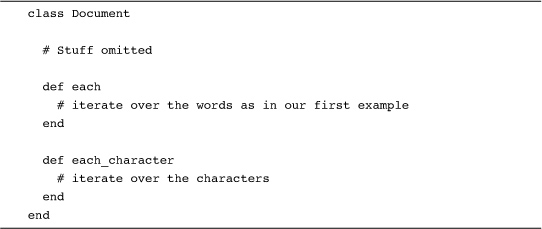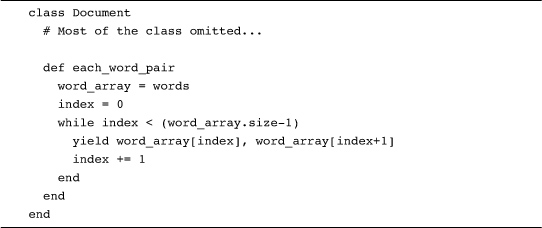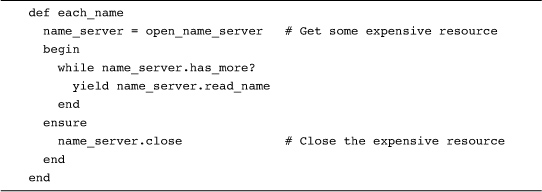Chapter 17. Use Blocks to Iterate
For programmers new to Ruby, code blocks are generally the first sign that they have definitely departed Kansas. Part syntax, part method, and part object, the code block is one of the key features that gives the Ruby programming language its unique feel. In fact, code blocks are kind of the Swiss Army Knife of Ruby programming; we use them for everything from initializing objects to building DSLs. In the next few chapters we will take a hard look at code blocks and the things you can do with them. The idea is to get beyond simply passing blocks to other people’s methods and move on to squeezing the last bit of utility out of the code blocks that get passed into your own methods.
We’re going to kick things off by looking at the most familiar use of code blocks—as iterators. After a quick review of the mechanics of code blocks we will move on to building simple iterators, iterators that can sequence through garden-variety collections. From there we will move on to iterators that run through collections that never actually exist. Next, we will also explore how you can mess up a perfectly good iterator and at how a misbehaving iterator can bring your code to a screeching halt. Finally, we will close by taking a quick tour of the myriad iterating code blocks that you will find in existing Ruby programs.
A Quick Review of Code Blocks
Since code blocks are one of the higher speed bumps on the road to real Ruby fluency, let’s take a minute to review the basics. In Ruby you create code blocks by tacking them on to the end of a method call, like this:
Or this:
do_something { puts "Hello from inside the block" }
When you tack a block onto the end of a method call, Ruby will package up the block as sort of a secret argument and (behind the scenes) passes this secret argument to the method. Inside the method you can detect whether your caller has actually passed in a block with the block_given? method and fire off the block (if there is one) with yield:

Blocks can take arguments, which you supply as arguments to yield, so that if you do this:

You will get:
The message is Hello World
Finally, like most everything else in Ruby, code blocks always return a value—the last expression that the block executes—which your yielding method can either use or ignore as it sees fit. So if you run this:
You will see the value of π/4:
The block returned 0.7853975
One Word after Another
The difference between the do_something and do_something_with_an_arg methods and a real iterator method is simple: An iterator method calls its block once for each element in some collection, passing the element into the block as a parameter. For example, we could add an iterator to our Document class, one that runs through all the words in the document:

The Document class, now sports a very respectable-looking Ruby iterator method, one that you can use like any other, so that running this:
Will result in this:

Although this each_word method is a good, simple illustration of how to build an iterating method, it does go out of its way to work hard. A real implementation of each_word would almost certainly take advantage of the existing each method in the words array:

There’s nothing like using the wheel that’s already there.
As Many Iterators as You Like
Although so far we have focused on adding an iterator to the Document class, a class can have as many iterator methods as make sense. So along with each_word, the Document class might also sport an each_character method:1

You are also free to name your iterator method anything you like, but it does make good sense to follow the Ruby convention and name your most obvious or commonly used iterator each and give any other iterators a name like each_something_else. We might, therefore, decide that words are the key elements of our documents and re-jigger our code to look something like:

Since it’s the words that count, we have made the each method run through the document one word at a time while consigning the method that runs through each character a lesser name.
Iterating over the Ethereal
An aspect of iterators that beginners often overlook is that you can write iterators that run through collections that don’t actually exist, at least not all at the same time. The simplest example of this sort of thing is the times method that you find on Ruby integers:
12.times { |x| puts "The number is #{x}" }
This code will print out the first dozen integers, but it will print them without ever assembling a twelve-element collection. Instead, the times method produces each number one at a time and feeds it to the block. So far, so obvious. What’s not so obvious is that you can use this same trick to build your own iterators. For example, people who are interested in determining the authorship of documents will sometimes gather statistics on which words are likely to appear together in a given document. If you had a document where the word “Mmmm” was frequently followed by the word “donuts,” you might guess that the author was Homer Simpson. We can help these authorship-seeking scholars by providing an each_word_pair method in the Document class:

Armed with each_word_pair, we can write some code to print out every pair of adjacent words in one of the world’s great bits of literature:
![]()
Which will produce:

Notice that we never actually build a four-element array of all the word pairs: We simply generate the pairs on the fly.
Enumerable: Your Iterator on Steroids
As I say, the Ruby convention is to name the main iterator of your class each, and one of the themes of this book is that you should try to stick to the conventions. There is, however, another reason to follow the crowd and name that key iterating method each: Doing so enables you to use the Enumerable module. The Enumerable module is a mixin that endows classes with all sorts of interesting collection-related methods. Here’s how Enumerable works: First, you make sure that your class has an each method, and then you include the Enumerable module in your class, like this:

The simple act of including Enumerable adds a plethora of collection-related methods to your class, methods that all rely on your each method. So, if you create an instance of the Enumerable-enhanced Document:
doc = Document.new('Advice', 'Harry', 'Go ahead make my day')
Then you can find out whether your document includes a given word with doc.include?, so that doc.include?("make") will return true, but doc.include?("Punk") will return false. Enumerable also enhances your class with a to_a method that returns an array of all of the items, in our case words, in your collection. The Enumerable module also adds methods that help you find things in your collection, methods with names like find and find_all.
Enumerable also contributes the each_cons method to your class. The each_cons method takes an integer and a block, and will repeatedly call the block, each time passing in an array of consecutive elements from the collection. So by including Enumerable in the Document class, the each_word_pair method would reduce down to:

Along the same lines as each_cons, Enumerable also supplies each_slice, which simply breaks up the collection in chunks of a given size and passes those into the block. Finally, if the elements in your collection define the <=> operator, you can use the Enumerable-supplied sort method, which will return a sorted array of all the elements in your collection. Since strings do indeed define <=>, we can get a sorted list of the words in our document with doc.sort.2 In all, Enumerable adds nearly 40 methods to your class—not a bad return on the effort of implementing one or two methods and mixing in a single module.
Nor are you simply stuck if, as with the latest Document class with its each and each_character and each_word_pair, you have more than one iterating method. Along with Enumerable, Ruby also comes with the Enumerator class. If you create an Enumerator instance, passing in your collection and the name of the iterating method, what you will get is an object that knows how to sequence through your collection using that method. For example, if you make a new Enumerator based on a Document instance and the each_character method:
![]()
Then you will end up with an object with all of the nice Enumerable methods based on the each_character method. Thus you can discover the number of characters in your document text:
puts enum.count
pp enum.sort
To produce:
[" ", " ", " ", "W", "a", "a", "a", "a", "c", ...]
Although the names are tricky, getting the hang of Enumerable and Enumerator is well worth the effort.
Staying Out of Trouble
The primary way that an iterator method can come to grief is by trusting the block too much. Remember, the code block you get handed in your iterator method is someone else’s code. You need to regard the block as something akin to a hand grenade, ready to go off at any second. We saw one aspect of this when we talked about Ruby’s collection classes: What happens if the code block changes the underlying collection? As we saw in Chapter 3, the Ruby collection classes generally throw up their arms and say “Don’t do that!” Our Document class is, however, made of stronger stuff. Since the Document each_word method actually creates a new array before it starts, the document can change any which way while the iteration is going on. The each_word method will continue to sequence through the words that were there when the iteration started.
Blocks can also blow up in your face with an exception:

A stray exception will not make much difference to the each_word method, but what if your iterator needs to acquire—and get rid of—some expensive resource? What if you have something like:

Now you have a problem. If the code block decides to raise an exception in mid-yield, then you’ll never get a chance to clean up that expensive resource. The answer to this problem is easy:

Even an exception-free block is no guarantee that your iterating method will run to completion. Ruby allows applications to call break in mid-block. The idea is to give the code using an iterating method a way to escape early:

When called from inside of a block, break will trigger a return out of the method that called the block. An explicit return from inside the block triggers an even bigger jump: It causes the method that defined (not called) the block to return. This is generally what you want to simulate breaking out of or returning from a built-in loop. Fortunately, like exceptions, both break and return will trigger any surrounding ensure clauses.
In the Wild
The fact is, you can’t swing a dead cat in the Ruby world without hitting some block-based iterators. Iterators in Ruby range from the very mundane to the fairly exotic. At the boring end of the spectrum we have the each method on the Array and Hash classes that we looked at in Chapter 3. Equally unexciting, but still very useful, is each method on the built-in Dir class. The Dir each method will iterate over all the files in a given directory:

Slightly more interesting is the each_address method on the Resolv3 class, which is part of the Ruby standard library. The Resolv class looks things up in DNS for you. Thus, with the each_address method you can discover all of the IP addresses associated with a given domain name. Run this:
![]()
And you will see something like:

At the more esoteric end of the spectrum, we have the each_object method on the standard class ObjectSpace. Called without any parameters, ObjectSpace.each_object will run through all the objects in your Ruby interpreter4 (yes, all of them!). Call ObjectSpace.each_object with a class and it will iterate through all of the instances of that class. For example, to see all of the strings that your Ruby interpreter knows about, run:
ObjectSpace.each_object(String) { |the_string| puts the_string }
Finally, if your taste in esoteric iterators runs more towards the mathematical, consider the each method on the Prime class. This method will call your block once for each and every prime number:

Of course, if you want to see all of the prime numbers, you’ll need to be patient.
Wrapping Up
In this chapter we looked at the iconic application of code blocks, as iterators. We saw how you can build as many iterator methods as you like for your classes, methods that take a block and call it for each item in some collection. We also saw how you can build iterators that sequence through collections that don’t actually exist. As long as you can come up with one element after another, you can build an iterator. We saw how Enumerable and Enumerator can enhance the iterating chops of your classes by providing most of the methods any collection class could imagine. We also saw how you need to treat the code blocks that get passed to your methods with a certain level of wary respect.
So much for iterators. In the next chapter we will look at a very different use for code blocks, one that turns the idea of an iterator on its head. Iterators are concerned with delivering item after item to a code block. We will see how you can reverse the polarity of code blocks and use them to deliver code to the right spot in your program.


